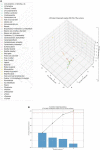Unraveling the tripartite interaction of volatile compounds of Streptomyces rochei with grain mold pathogens infecting sorghum
- PMID: 35966704
- PMCID: PMC9366667
- DOI: 10.3389/fmicb.2022.923360
Unraveling the tripartite interaction of volatile compounds of Streptomyces rochei with grain mold pathogens infecting sorghum
Abstract
Sorghum is a major grain crop used in traditional meals and health drinks, and as an efficient fuel. However, its productivity, value, germination, and usability are affected by grain mold, which is a severe problem in sorghum production systems, which reduces the yield of harvested grains for consumer use. The organic approach to the management of the disease is essential and will increase consumer demand. Bioactive molecules like mVOC (volatile organic compound) identification are used to unravel the molecules responsible for antifungal activity. The Streptomyces rochei strain (ASH) has been reported to be a potential antagonist to many pathogens, with high levels of VOCs. The present study aimed to study the inhibitory effect of S. rochei on sorghum grain mold pathogens using a dual culture technique and via the production of microbial volatile organic compounds (mVOCs). mVOCs inhibited the mycelial growth of Fusarium moniliforme by 63.75 and Curvularia lunata by 68.52%. mVOCs suppressed mycelial growth and inhibited the production of spores by altering the structure of mycelia in tripartite plate assay. About 45 mVOCs were profiled when Streptomyces rochei interacted with these two pathogens. In the present study, several compounds were upregulated or downregulated by S. rochei, including 2-methyl-1-butanol, methanoazulene, and cedrene. S. rochei emitted novel terpenoid compounds with peak areas, such as myrcene (1.14%), cymene (6.41%), and ç-terpinene (7.32%) upon interaction with F. moniliforme and C. lunata. The peak area of some of the compounds, including furan 2-methyl (0.70%), benzene (1.84%), 1-butanol, 2-methyl-(8.25%), and myrcene (1.12)%, was increased during tripartite interaction with F. moniliforme and C. lunata, which resulted in furan 2-methyl (6.60%), benzene (4.43%), butanol, 2-methyl (18.67%), and myrcene (1.14%). These metabolites were implicated in the sesquiterpenoid and alkane biosynthetic pathways and the oxalic acid degradation pathway. The present study shows how S. rochei exhibits hyperparasitism, competition, and antibiosis via mVOCs. In addition to their antimicrobial functions, these metabolites could also enhance plant growth.
Keywords: S. rochei; antifungal; grain mold; interaction; mVOCs; sorghum.
Copyright © 2022 Appusami, Durgadevi, Archana, Muthukumar, Suthin Raj, Nakkeeran, Poczai, Nasif, Ansari and Sayyed.
Conflict of interest statement
The authors declare that the research was conducted in the absence of any commercial or financial relationships that could be construed as a potential conflict of interest.
Figures







Similar articles
-
Comprehensive profiling of the VOCs of Trichoderma longibrachiatum EF5 while interacting with Sclerotium rolfsii and Macrophomina phaseolina.Microbiol Res. 2020 Jun;236:126436. doi: 10.1016/j.micres.2020.126436. Epub 2020 Mar 2. Microbiol Res. 2020. PMID: 32179388
-
Antifungal Effect and Protective Role of Ursolic Acid and Three Phenolic Derivatives in the Management of Sorghum Grain Mold Under Field Conditions.Chem Biodivers. 2016 Sep;13(9):1158-1164. doi: 10.1002/cbdv.201500515. Epub 2016 Aug 31. Chem Biodivers. 2016. PMID: 27447843
-
Effects of Wetness Duration and Grain Development Stages on Sorghum Grain Mold Infection.Plant Dis. 2005 Aug;89(8):872-878. doi: 10.1094/PD-89-0872. Plant Dis. 2005. PMID: 30786520
-
The Sorghum Grain Mold Disease Complex: Pathogens, Host Responses, and the Bioactive Metabolites at Play.Front Plant Sci. 2021 May 28;12:660171. doi: 10.3389/fpls.2021.660171. eCollection 2021. Front Plant Sci. 2021. PMID: 34122480 Free PMC article. Review.
-
Pathogen suppression by microbial volatile organic compounds in soils.FEMS Microbiol Ecol. 2019 Aug 1;95(8):fiz105. doi: 10.1093/femsec/fiz105. FEMS Microbiol Ecol. 2019. PMID: 31265069 Review.
Cited by
-
Streptomyces-Based Bioformulation to Control Wilt of Morchella sextelata Caused by Pestalotiopsis trachicarpicola.J Fungi (Basel). 2025 Jun 13;11(6):452. doi: 10.3390/jof11060452. J Fungi (Basel). 2025. PMID: 40558963 Free PMC article.
-
How Do Plant Growth-Promoting Bacteria Use Plant Hormones to Regulate Stress Reactions?Plants (Basel). 2024 Aug 26;13(17):2371. doi: 10.3390/plants13172371. Plants (Basel). 2024. PMID: 39273855 Free PMC article. Review.
-
Bioactive Metabolite Survey of Actinobacteria Showing Plant Growth Promoting Traits to Develop Novel Biofertilizers.Metabolites. 2023 Mar 2;13(3):374. doi: 10.3390/metabo13030374. Metabolites. 2023. PMID: 36984814 Free PMC article.
-
A Coating Based on Bioactive Compounds from Streptomyces spp. and Chitosan Oligomers to Control Botrytis cinerea Preserves the Quality and Improves the Shelf Life of Table Grapes.Plants (Basel). 2023 Jan 28;12(3):577. doi: 10.3390/plants12030577. Plants (Basel). 2023. PMID: 36771661 Free PMC article.
-
Recent advances in PGPR-mediated resilience toward interactive effects of drought and salt stress in plants.Front Microbiol. 2023 Sep 27;14:1214845. doi: 10.3389/fmicb.2023.1214845. eCollection 2023. Front Microbiol. 2023. PMID: 37829451 Free PMC article. Review.
References
-
- Abdelmoteleb A., González-Mendoza D. (2020). A novel streptomyces rhizobacteria from desert soil with diverse anti-fungal properties. Rhizosphere 16:100243. 10.1016/j.rhisph.2020.100243 - DOI
-
- Almaghrabi O. A., Abdelmoneim T. S., Albishri H. M., Moussa T. A. (2014). Enhancement of maize growth using some plant growth promoting rhizobacteria (PGPR) under laboratory conditions. Life Sci. J. 11 764–772.
-
- Basu A., Prasad P., Das S. N., Kalam S., Sayyed R. Z., Reddy M. S., et al. (2021). Plant growth promoting rhizobacteria (PGPR) as green bioinoculants: recent developments, constraints, and prospects. Sustainability 13:1140.
LinkOut - more resources
Full Text Sources
Research Materials
Miscellaneous

